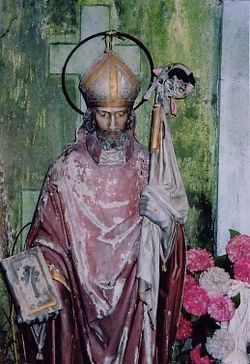 Statue of St. Colman
Statue of St. Colman The future saint was born in Ireland into the family of a chief named Duagh (hence the full name of the saint—Colman Mac Duagh, that is, “Colman, son of Duagh”) and his wife Rhinagh. His birthplace may have been Corker in Galway, which is a pilgrimage site to this day. When he was still in his mother’s womb, she heard a prophecy that her son would become a great man who would surpass in his glory all men in his lineage. According to tradition, the jealous father understood these words not in the spiritual, but in the secular sense and bore malice to the still unborn child. The pregnant mother, fearing for her baby’s safety, fled from their home. However, Duagh’s servants soon found her, tied a heavy stone around her neck and threw her into the river Kiltartin. But by the grace of God Rhinagh was cast ashore, survived and gave birth. The very stone to which she was tied, with marks of the rope, has survived and is kept inside a church in Corker.
When it was time to baptize the newly-born Colman, the priest who came to Rhinagh found that there was no water to perform the baptism. The mother, fearing to go back home, took shelter under an ash-tree. She prayed hard and suddenly a holy spring gushed forth from under the ground near the tree and the baby was baptized in it. Many healings and other miracles occurred from the pure water of this spring, which still exists in Corker near the river and attracts many pilgrims (there are many modern reports of healing from it). Rhinagh entrusted her boy to the care of pious monks.
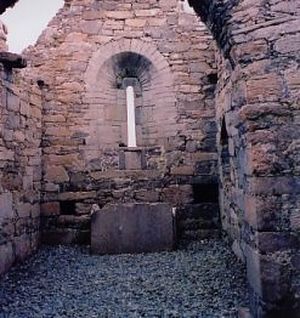 One of two churches founded by St.Colman on Aranmore
One of two churches founded by St.Colman on Aranmore Already a young man, Colman arrived on the Aran Islands in Donegal where he remained for some years under the great Irish Abbot St. Enda of Inishmore.1 Colman became a monk there and was later ordained priest. According to tradition, St. Colman spent several years as a hermit on Aranmore Island where he also built two churches—the ruins of both of them can still be seen. Aranmore was always known as an island with extremely harsh conditions for life; in spite of this, a multitude of ascetics lived and prayed there for many years throughout “the age of saints” in Ireland.
St. Colman’s zeal and thirst for spiritual perfection were so strong that with time he resolved to leave the island monastery and to retreat to a remote and quiet place to pray more deeply. Thus, according to tradition, from 592 the holy man lived for seven years alone in solitude in the dense Burren forests of County Clare, and obtained the gift of unceasing prayer; he prayed and kept vigil day and night, ate only herbs, drank water and wore a deerskin. In his ascetic practices St. Colman imitated the Egyptian hermits, headed by St. Anthony; many other Celtic saints lived in the same spirit in those centuries. Colman’s hermitage was situated in a perfect setting surrounded by wild forest and the beautiful Burren mountains.
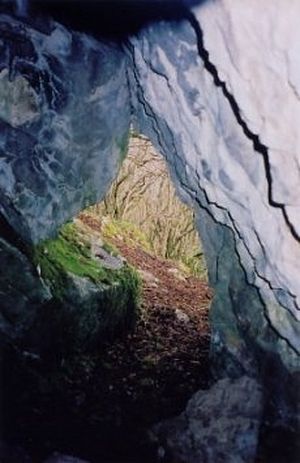 St.Colman's cave, Burren forest
St.Colman's cave, Burren forest St. Colman made himself a tiny dwelling in a very small cave on a steep slope where he spent most of his time praying. This cave, known as St. Colman’s cave, has been well-preserved to this day. The saint also built a little chapel at the foot of the cliff where he celebrated the services alone. This St. Colman’s Chapel existed for many centuries after him but was severely damaged by puritan iconoclasts in the seventeenth century. However, its ruins survive and still preserve a particular spirit of holiness, which is evidenced by pilgrims who visit this place to this day. The saint drank water from the natural holy well located near the chapel. By the grace of God this holy well survives in good condition, and numerous miracles still occur through its water today.
Like many Irish saints, St. Colman lived in harmony with wild nature. Various versions of his life relate the same and truly striking story (though with different minor details) about the communication of the holy man with animals. This story says that a cock, a mouse, and a fly were Colman’s closest friends in Burren. All of them served their holy master as they could. The cock crowed at a certain time every night, reminding the saint of the time for prayer; the mouse gently touched his face, thus waking him up and ensuring that he slept only five hours per day; the fly carefully crept over the lines of the sacred books that he read, and when his eyes got tired or when the saint had to move away for a while, the fly crawled onto the first letter of the following sentence so that he could never lose his place.
 Burren forest today
Burren forest today The saint loved and fed these faithful friends. Once Colman got so tired that he fell into a very deep sleep and the mouse could not awaken him as usual. Then it began scratching his ear so hard that Colman awoke immediately: he praised the animal and gave it more food from that time on. One day the saint was away for more than an hour, conversing with a guest. On his return he noticed that the fly was sitting without movement on the very word in his prayer-book where he had stopped before leaving. The saint praised the fly for its zeal and began giving it more breadcrumbs with drops of honey as a treat. But by the end of summer all of them died on the same day: the fly was the first and the mouse and cock died after it from grief. In his sorrow St. Colman wrote a letter to his friend, St. Columba of Iona, telling him this story. And St. Columba sent a letter in reply: “When you had these friends, brother, you were rich. That is why you are in sorrow now. Such sorrows come due to riches. So try not to have riches any more.” And Colman realized that one can be rich even without money.
In the seventh year of Colman’s solitude it came to pass that after spending Lent in fasting and prayer, St. Colman had nothing to eat on the day of Holy Easter. At the same time the pious and generous King Guaire of Connacht (possibly the saint’s cousin) was about to celebrate Easter with his retinue, sitting at table with sumptuous dishes. Suddenly the king exclaimed: “May all of our dinner by Divine providence go to some worthy servant of God! And we will do without such a luxury today.” And at once invisible angels carried all the dishes from the royal table to St. Colman’s cave. The king ordered his men to find out: Who is this holy man to whom angels brought food? And soon the hermit Colman was found. The king marveled at his ascetic life, promised to give him land to found a monastery, and assigned sufficient means to maintain it.
Thus St. Colman left his hermitage and began to serve people. Soon his glory as a wonderworker spread all over the region. Many people came to Colman and obtained healing and consolation. Once the saint’s belt fell on the ground not far from his former hermitage and it was a sign that he was to build a monastery on that spot. The monastery was called Kilmacduagh (“church of the son of Duagh”) and Colman became its first abbot. (His belt was later kept as a relic and many were healed by it). Much against his will, St. Colman was also probably ordained bishop of the region with its center in Kilmacduagh and founded the first cathedral there. Colman, being a bishop and abbot at the same time, labored with all his zeal as a true good pastor, caring for all the monasteries and convents in his diocese and kindling the hearts of his flock with fervent love for Christ our Saviour. But life “in the world” (in comparison with his former seclusion), the fame and praise from people were a burden to him, and with all his heart he desired to return to his beloved way of life one day. And after many years of service to people, the saint resigned his episcopacy seven years before his death. The saint settled in the Oughtmama valley in the Burren area where he reposed on October 29, 632, at a very advanced age.
St. Colman was venerated as a saint immediately after his death and became the patron-saint of Kilmacduagh. In addition to his main relics, the episcopal vestments and the personal staff of St. Colman were kept as precious relics for many centuries, and the staff is still preserved at the National Museum in Dublin—it was used for the taking of oaths in the late medieval period. According to legend, the saint predicted that no man or animal would ever be killed by lightning in the diocese of Kilmacduagh and it is said that this is true to this day.
In medieval times, Kilmacduagh Monastery gained great popularity and excelled in preserving ascetic traditions. This religious site was so important that from the twelfth century on a permanent diocese existed here. Unfortunately, Vikings made raids on the monastery, and it was eventually plundered in the twelfth century. In the thirteenth century an Augustinian Abbey appeared on the site. This monastery was dissolved at the Reformation.
Today Kilmacduagh is a small village in the south of County Galway near the town of Gort. It continues to be a holy site and a destination for pilgrimages. Many ancient picturesque ruins survive, including ruins of the cathedral, monastery churches (St. Mary’s, St. John the Baptist’s and others) and monastic buildings (the abbots’ house). One of its gems is an ancient Irish round tower—the highest surviving such tower in the country (112 feet).
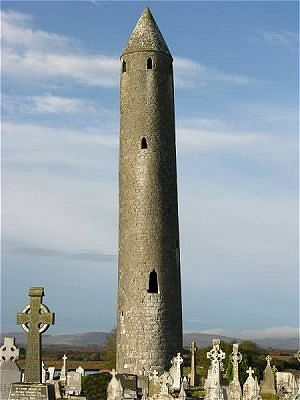 Round tower in Kilmacduagh
Round tower in Kilmacduagh Saint Colman of Kilmacduagh, pray to God for us!

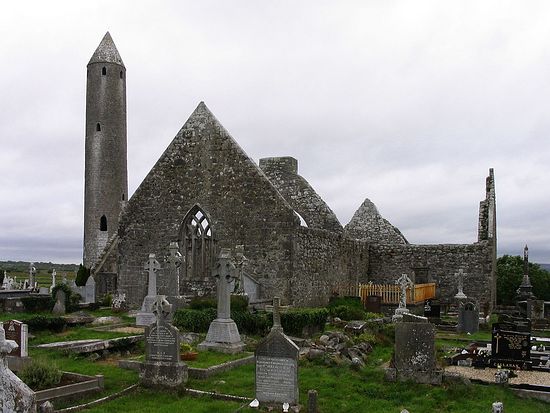
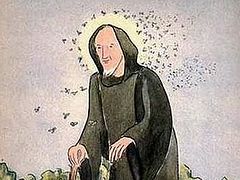
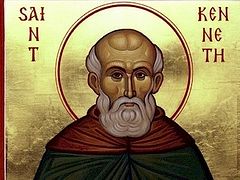
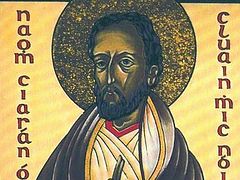
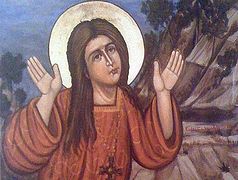
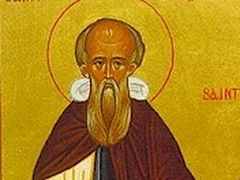
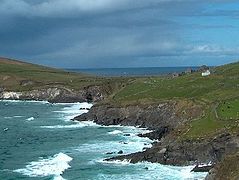
It's truly a blessing to know more about this wonderful saint! I would love to go on a pilgrimage to holy sites in Ireland and other western European countries. I know some such pilgrimages have been undertaken.
May God bless us all through the prayers of this great, ascetic, monk (and perhaps bishop), St. Colman, all the Irish ascetics and saints, and all His holy servants who have shown forth in this wicked and sinful world. Amen